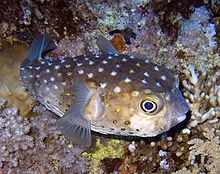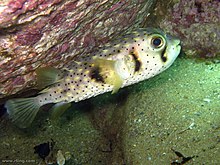Hedgehog fish
| Hedgehog fish | ||||||||||||
|---|---|---|---|---|---|---|---|---|---|---|---|---|

Diodon holocanthus |
||||||||||||
| Systematics | ||||||||||||
|
||||||||||||
| Scientific name | ||||||||||||
| Diodontidae | ||||||||||||
| Billberg , 1833 |
The porcupine fish (Diodontidae) are a family in the order of the puffer fish relatives (Tetraodontiformes) with around 20 species . The scientific name literally means “two teeth” ( Greek di- “two”, odont- “tooth”).
habitat
Porcupine fish live in shallow subtropical and tropical seas off the coast. There they inhabit the coral reefs. Some species are also found in the open sea, sometimes gathering in large groups. They move slowly when swimming.
description
Like the puffer fish, porcupine fish have spines on their bodies, which are much larger and stronger. In the case of the genus Diodon, these are close to the body, in the case of the genus Chilomycterus they are firmly attached to the body. The spines were made from bone plates. In the event of danger, they pump themselves up with water so that the spines stand up. In this defensive position they can only be swallowed by a few large fish. In humans, it can cause severe inflammation when they are injured by the spines.
In the upper and lower jaw there are tooth plates that are fused together in the middle of the upper and lower jaw. Porcupine fish feed mainly on small shellfish, which they deftly expose into the sea bed by powerful "blowing". With the toothed plates and extremely strong jaw muscles, they crack open the shells in order to eat the edible contents.
Systematics
-
Allomycterus
- Allomycterus pilatus Whitley, 1931
-
Chilomycterus
- Bridle hedgehogfish ( Chilomycterus antennatus ) (Cuvier, 1816)
- Chilomycterus antillarum Jordan & Rutter, 1897
- Gray hedgehogfish ( Chilomycterus reticulatus ) (Linnaeus, 1758)
- Chilomycterus schoepfii (Walbaum, 1792)
- Chilomycterus spinosus mauretanicus (Le Danois, 1954)
- Chilomycterus spinosus spinosus (Linnaeus, 1758)
-
Cyclichthys
- Cyclichthys hardenbergi (de Beaufort, 1939)
- Short-spined porcupinefish ( Cyclichthys orbicularis ) (Bloch, 1785)
- Yellow-spotted porcupinefish ( Cyclichthys spilostylus ) (Leis & Randall, 1982)
-
Dicotylichthys
- Dicotylichthys punctulatus Kaup, 1855
-
Diodon
- Diodon eydouxii Brisout de Barneville, 1846
- Brown-spotted porcupinefish ( Diodon holocanthus ) Linnaeus, 1758
- Spotted porcupine fish ( Diodon hystrix ) Linnaeus, 1758
- Masked porcupinefish ( Diodon liturosus ) Shaw, 1804
- Long- spiked porcupine fish ( Diodon nicthemerus ) Cuvier, 1818
- Lophodiodon
-
Tragulichthys
- Tragulichthys jaculiferus (Cuvier, 1818)
Danger
Porcupine fish are very endangered as they are caught in large numbers for tourist purposes. The dead animals are prepared and sold in the inflated state. Many local fishermen in tourist countries earn more money with this purchase than with fishing.
literature
- Joseph S. Nelson : Fishes of the World , John Wiley & Sons, 2006, ISBN 0-471-25031-7 .
- Kurt Fiedler: Textbook of Special Zoology, Volume II, Part 2: Fish , Gustav Fischer Verlag Jena, 1991, ISBN 3-334-00339-6 .
- Rudie H. Kuiter / Helmut Debelius : Atlas der Meeresfische , Kosmos-Verlag, 2006, ISBN 3-440-09562-2 .
- Hans A. Baensch / Robert A. Patzner: Mergus Sea Water Atlas Volume 6 Non-Perciformes (Non-Perciformes) , Mergus-Verlag, Melle, ISBN 3-88244-116-X .
- Ewald Lieske / Robert F. Myers: Coral fish of the world , 1994, year publisher, ISBN 3-86132-112-2 .
Web links
- Hedgehog fish on Fishbase.org (English)


